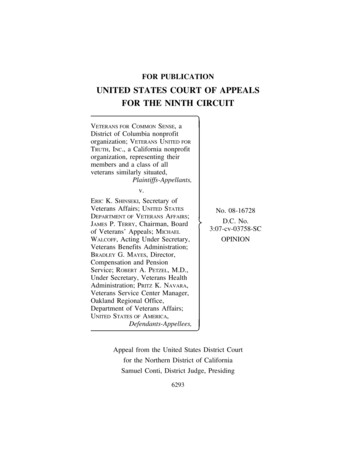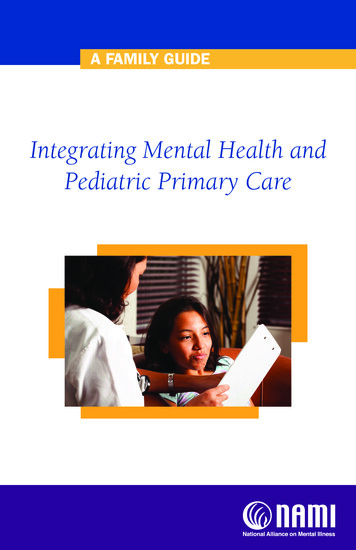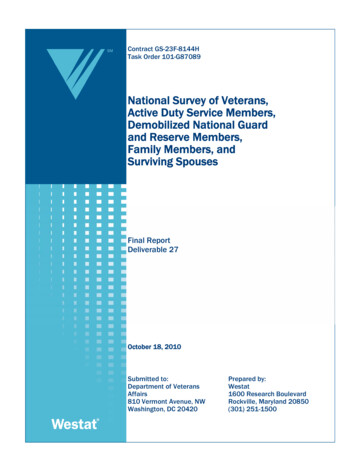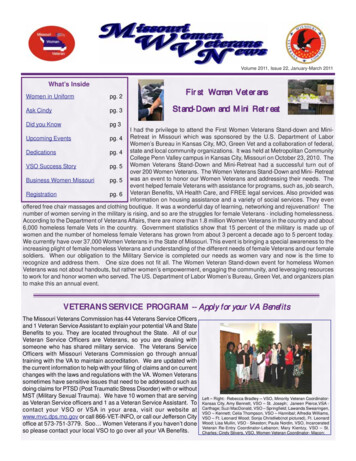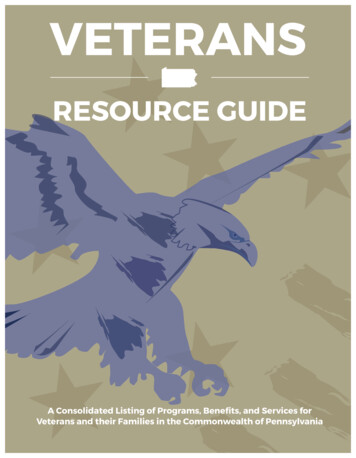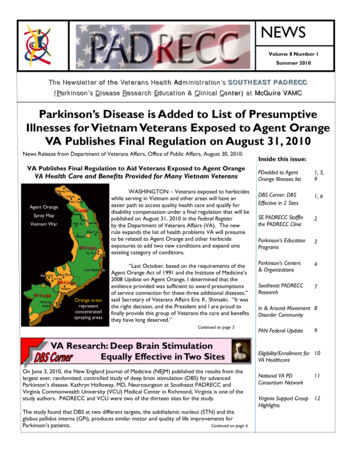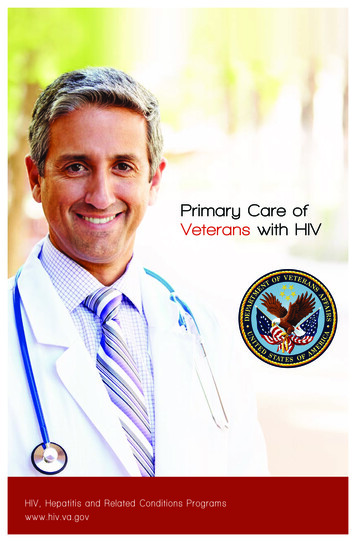
Transcription
Primary Care ofVeterans with HIVHIV, Hepatitis and Related Conditions Programswww.hiv.va.gov
Primary Care ofVeterans with HIVHIV, Hepatitis and Related Conditions Programs (HHRC)in the Office of Specialty Care ServicesVeterans Health AdministrationU.S. Department of Veterans AffairsJanuary 2019
IM PORTA NT NOTI CEThe editors of this manual are committed to providing accurateinformation on HIV-related care. However, please be awarethat therapy options and protocols continue to change. Readers areinvited to check for updates to drug information at er/drugsatfda/)and to treatment guidelines at AIDS Info (http://aidsinfo.nih.gov/).We hope that you will send feedback and suggestions for futureeditions to: VHAHHRC@va.gov
Table of ns.xiiCaring for a Veteran with HIVCaring for a Veteran with HIV.3Interactions TablesCommon Medications:ARV Interactions.11Food and Supplements: ARV Interactions.23Lipid-Lowering Medications.25Pain Medications: Dosage and Indications.31Psychoactive Medications: ARV Interactions.41Prevention of HIV Transmission with PositivesSafe Conception (for HIV Men and Women).47Sexually Transmitted Infections (STI) Screening and Resources .55Pregnancy and HIV-Limiting Transmission to Fetus. 71PrEP for Sexual and Drug Partners.81Behavioral HealthSubstance UseAlcohol Use.91Substance Use.107Tobacco Use.127Mental HealthDepression.149PTSD and Trauma Informed HIV Care.165Serious Mental Illness (Bipolar Disorder, Schizophrenia, etc.).189Health Management for People Living with HIVCancer ary c are of veterans with hivv
Important or High-Risk PopulationsHomeless Health.237Lesbian, Gay, Bi-Sexual, and Transgender (LGBT) Health.249Palliative Care.271Women’s Health.283Comorbid ConditionsAnal Dysplasia.315Androgen Deficiency.327Bone Health.335Cirrhosis.343Coronary Artery Disease.365Dermatologic Conditions.371Diabetes Mellitus.397Dyslipidemia.417Gastroesophageal Reflux Disease (GERD). 431Hepatitis B.449Hepatitis C.463HIV and Aging.469Hypertension.479Renal Disease.497Sexually Transmitted Infections (STI).521HIV and Pain ManagementLow Back Pain.529Peripheral Neuropathy.543Chronic Pain in HIV – General Management.555Index.561viprimary c are of veterans with hiv
ContributorsEDITOR-IN-CHIEFEDITORIAL STAFFDavid Ross, MD, PhD, MBILorenzo L. McFarland, DHA,Director, HIV, Hepatitis and RelatedConditions ProgramsOffice of Specialty Care Ser vices, VHAWashington, DCEDITORElizabeth Maguire, MSWProject Manager, SCALEBedford VA Medical CenterBedford, MAMPH, MSW, PMPSenior Program ManagerHIV, Hepatitis and Related ConditionsProgramsOffice of Specialty Care Ser vice, VHABellville, TXMarguerite PetrucciNational Program CoordinatorHIV, Hepatitis and RelatedConditions ProgramsOffice of Specialty Care Ser vice,VHAWest Haven, CTMatt JohnstonProject ManagerInstructus Media, LtdRoberta Ambrosino, EdDEditorial ManagerInstructus Media, LtdSue PhelpsSr. Copy EditorInstructus Media, LtdAUTHORSGregory Anstead, MD, PhDSouth Texas Veterans Health CareSystem and University of Texas HealthSan Antonio, TexasChester Ashong, PharmD,AAHIVPAustin De La Cruz, PharmD,BCPPHeta Javeri, MDFamily-focused AIDSUniversity of Houston College ofPharmacy; Depar tment of PharmacyPractice and Translational ResearchHouston, TexasClinical Treatment Ser vices andUniversity of Texas HealthSan Antonio, TexasPaul DenOuden, MDMichael E Debakey VA Medical CenterTexasHouston, TexasMultnomah County HIV HealthSer vices CenterPor tland, OregonAngela R. Boyd, MD, PhDDozie Dike, PharmDCandidateUniversity of Texas HealthSan Antonio, TexasGeorge Crawford, MDUniversity of Houston College ofPharmacyHouston, TexasUniversity of Texas HealthSan Antonio, TexasChristopher Dyer, MDBrock Davis, PASouth Texas Veterans HealthcareSystem and University of Texas HealthSan Antonio, TexasMichael E Debakey VA Medical CenterTexasHouston, TexasFrances Deavers, PhDMichael E Debakey VA Medical CenterTexasHouston, TexasJuan Echevarria, MD, MSSouth Texas Veterans HealthcareSystem and University of Texas HealthSan Antonio, TexasSarah Fritz, PhDMichael E Debakey VA Medical CenterTexasHouston, Texasprimary c are of veterans with hivLavonne Johnson, DNP,APRN, NP-CSouth Texas Veterans HealthCare SystemSan Antonio, TexasBinh Le, PharmDCandidateUniversity of Houston Collegeof PharmacyHouston, TexasMahsa Mansouri, MDUT Dell Medical CenterAustin,TexasMarco Marcelli, MDMichael E Debakey VAMedical Center TexasHouston, TexasJoseph Tiscani, DNP,MSN, APRN, FNP-BCDiabetes & GlandularDisease Clinic, P.A.San Antonio, Texasvii
Cezarina Mindru, MDMichael E Debakey VA MedicalCenter TexasHouston, TexasKimberly Parks, MDBaylor College of MedicineHouston, TexasRachel Rogers, PharmD,BCPS, AAHIVPSouth Texas Veterans Health CareSystem and University of Texas HealthSan Antonio, TexasLana Wong, PharmD, BCPSSouth Texas Veterans HealthcareSystemSan Antonio, TexasTara Steinberg, PhDMichael E Debakey VA Medical CenterTexasHouston, TexasJason Phillips MDUniversity of Texas HealthSan Antonio, TexasREVIEWERSWari Allison MD, PhDSan Antonio AIDS Foundationand University of Texas HealthSan Antonio, TexasDelia E Bullock, MDMarian Santillan-Rabe,NP-CFamily-Focused AIDS ClinicalTreatment Ser vicesSan Antonio, TexasFamily-focused AIDS ClinicalTreatment Ser vices andUniversity of Texas HealthSan Antonio, TexasDana Wong, PharmD, BCPSLakeisha Hester,LCSWJose Cadena Zuluaga, MDSouth Texas VeteransHealthcare SystemSan Antonio, TexasRushit Kanakia, MDSouth Texas Veterans HealthcareSystemSan Antonio, TexasSouth Texas Veterans HealthcareSystem and University of Texas HealthSan Antonio, TexasGregory Aung, PharmD,BCPS, AAHIVPSouth Texas VeteransHealthcare System andUniversity of Texas HealthSan Antonio, TexasVA Loma Linda Healthcare SystemLoma Linda, CaliforniaMehdi Khosvari, MDVA Nor th Texas Health Care Systemand Professor of Medicine, UTSouthwestern Medical CenterDallas, TexasUniversity of KentuckyLexington, KentuckyHerman Montalvo,LCSW, ACSWSouth Texas VeteransHealthcare SystemSan Antonio, TexasRoger Bedimo, MD, MS,FACP, FIDSAPamela Belperio, PharmD,BCPS, AAHIVPPatrick S. Ramsey, MD,MSPHUniversity of Texas HealthSan Antonio, TexasviiiJames J Peters VA Medical CenterBronx, New YorkMary Burton, PhDSalem VA Medical CenterSalem, VirginiaMaggie Chartier, PsyD, MPHDeputy Director, HIV, Hepatitisand Related Conditions ProgramsOffice of Specialty Care Ser vices,VHASan Francisco, CaliforniaTimothy Chen, PharmD,BCACP, CGPVA San Diego Healthcare System(VASDHS)San Diego, CaliforniaMaggie Czarnogorski, MDWashington DC VA Medical CenterWashington, DCJason Dominitz, MD, MHS,FASGE, AGAFVA Puget Sound Healthcare SystemSeattle, WashingtonVA Greater Los Angeles HealthcareSystemLos Angeles, CaliforniaMoira Dux, PhDMary Bessesen, MDCynthia Gibert, MD, MSc,FACP, FIDSAMark A. Perazella, MDYale UniversityNew Haven, ConnecticutNorbert Bräu, MD, MBA,FAASLDVA Eastern Colorado Health CareSystemDenver, ColoradoJessica Brand, PhDVA Puget Sound Health Care SystemSeattle, WashingtonVA Mar yland Health Care SystemBaltimore, Mar ylandWashington DC Veterans AffairsMedical CenterWashington, DCShelley A. Gilroy, MD, FIDSASamuel S. Stratton VA Medical CenterAlbany, Ney Yorkprimary c are of veterans with hiv
Elizabeth Glinka Armstrong,PharmD, BCPSStephanie Ring, PharmD,BCACPVA Deser t Pacific HealthcareNetwork (VISN 22)San Diego, CaliforniaJames H. Quillen VA Medical CenterMountain Home, TennesseeMatthew Goetz, MDVA Greater Los Angeles HealthcareSystemLos Angeles, CaliforniaSandra Gompf, MD FACPFIDSAMaria Rodriguez-Barradas,MDMichael E DeBakey VA MedicalCenterHouston, TexasDavid Rosenthal, MDJames A. Haley Veterans HospitalTampa, FloridaVA Connecticut HealthcareSystemWest Haven, ConnecticutShaili Gupta, MBBSJillian Shipherd, MA, PhDVA Connecticut Healthcare SystemWest Haven, ConnecticutVA Boston Healthcare SystemBoston, MassachusettsKatherine Imhoff-Witt,PharmD, BCPSScott T. Shreve, DOCincinnati VA Medical CenterCincinnati, OhioAmy Justice, MD, MSc, PhDVA Connecticut HealthcareSystemWest Haven, ConnecticutMichael R. Kauth, PhDMichael E Debakey VA Medical CenterTexas and Professor, Depar tment ofPsychiatr y, Baylor College of MedicineHouston, TexasRobert Lavin, MDVA Mar yland Health Care SystemBaltimore DivisionBaltimore, Mar ylandCarol A. Luhrs, MDVA New York Harbor Health CareSystemNew York, New YorkLebanon VA Medical CenterLebanon, PennsylvaniaJason Sico, MDVA Connecticut Healthcare SystemWest Haven, ConnecticutPuja Van EppsLouis Stokes Cleveland VA MedicalCenterCleveland, OhioF. Perry Wilson, MD MSCEYale University School of MedicineNew Haven, CTJulie Womack, CNM, APRN,PhDYale University School of MedicineNew Haven, CTHowa Yeung, MDEmor y University School of MedicineAtlanta, GeorgiaSheran Mahatme, DOAlbany Stratton VA Medical CenterAlbany, NYJamie P. Morano, MD, MPHJames A. Haley Veterans’ Hospital,Infectious Disease SectionTampa, FloridaArianna E A. Perra, PsyDVA Mar yland Health Care SystemBaltimore, Mar ylandprimary c are of veterans with hivix
IntroductionIn 2009, the first edition of Primary Care of Veterans with HIV was released, quicklybecoming an important resource for providers delivering high-quality primary care to Vet erans living with HIV. Over the past decade, as more Veterans with HIV infection in carein facilities operated by the U.S. Department of Veterans Affairs (VA) have been diagnosed,linked to care, and started on highly active antiretroviral therapy (HAART), the role of pri mary care has grown, with much of this care provided not only through HIV specialty careclinics but also via Infectious Disease-Patient Aligned Care Teams. Much of this is providednot only through HIV specialty care clinics but also via infectious Disease-Patient AlignedCare Teams.The phenomenal benefits of HAART are perhaps best illustrated by survivalof these Veterans into their eighth decade of life. Over the last decade, the proportion ofVeterans in VA care with HIV aged 70 years and up has increased from 5% to 15%. Theaging of this population has made management of conditions traditionally associated withother individuals, such as cardiovascular disease, diabetes, and malignancy, even moreimportant.Recognizing a continued need to focus on age-related comorbid illnesses, substanceuse, and other critical issues for Veterans living with HIV, we have updated and added tothis original resource.This manual serves as a point-of-care reference for HIV cliniciansproviding HIV and primary care to their HIV patients. We hope it will also be of use tonon-VA providers who care for Veterans with HIV outside of the VA healthcare system.This manual is meant to be a practical guide to screening and treatment of many of themost common and serious comorbid conditions among people living with HIV.The HIV, Hepatitis, and Related Conditions Programs in the VA Office of Specialty CareServices would like to thank all the VA subject matter experts who contributed to theupdate of this manual. We gratefully acknowledge their expertise, enthusiasm, and thecountless hours they dedicated to revising a resource aimed at improving the care andwell-being of our Veterans. We also extend our thanks to members of the VA HIV Techni cal Advisory Group for their advice and guidance.Comments and suggestions regarding this manual are welcome, and can be e-mailed tohivhhrc@va.gov.This manual is dedicated to all the providers across the VA system who strive to provideexcellent HIV care to our Veterans, and to the Veterans who have entrusted the VA withtheir care.David Ross, M.D., Ph.D., M.B.I.Director, HIV, Hepatitis, and Related Conditions ProgramsOffice of Patient Care ServicesAssociate Clinical Professor of MedicineGeorge Washington University School of Medicine and Health SciencesStaff Physician, Infectious Diseases SectionWashington, DC Department of Veterans Affairs Medical Centerprimary c are of veterans with hivxi
Abbreviations forAntiretroviral Drugs and Dosing InstructionsCommonly Used in This ManualDOSING TERMINOLOGYANTIRETROVIRAL DRUGSBID twice daily3TC lamivudineIM intramuscularABC abacavirIV intravenousAPV amprenavirPO orallyATV atazanavirPRN as neededd4T stavudineQ2H, Q4H, etc every 2 hours,ddC zalcitabineevery 4 hours, etcddI didanosineQAM every morningDLV delavirdineQD once dailyDRV darunavirQH every hourEFV efavirenzQHS every night at bedtimeENF enfuvirtideQID 4 times per dayETR etravirineQOD every other dayFPV fosamprenavirTID 3 times per dayFTC emtricitabineTIW 3 times per weekIDV indinavirLPV/r lopinavir/ritonavirANTIRETROVIRAL TERMINOLOGYMVC maravirocART antiretroviral therapyNFV nelfinavirARV antiretroviralNVP nevirapineFI fusion inhibitorRAL raltegravirNNRTI nonnucleosideRTV ritonavirreverse transcriptase inhibitor/r ritonavir, low doseNRTI nucleoside (or nucleotide)SQV saquinavirreverse transcriptase inhibitorTDF tenofovirPI protease inhibitorTPV tipranavirZDV zidovudinexiiprimary c are of veterans with hiv
Caring for a Veteran with HIV
Caring for a Veteran with HIVWide availability of antiretroviral (ARV) therapy regiments enables most patientsinfected with Human Immunodeficiency Virus (HIV) to enjoy the same lifeexpectancy as the general population. ARV therapy is now recommended forall patients who are HIV-infected, regardless of their CD4 cell count, to reducemortality, morbidity and transmission rate. Upon starting ARV therapy, it isimportant to educate patients about benefits and side effects, and address strate gies to increase adherence.One in 96 Americans will be diagnosed with HIV in their lifetime.The malepopulation has a higher estimated lifetime risk than the female population. Exactstatistics in the Veteran population has not yet been studied.ARV therapy side effects and drug interactions are numerous and complex.Within the infected population, the primary care clinician is the first line ofdefense against poor adherence to the treatment and aggravated side effects. SeeComorbid Conditions, p. 313, for more information about side effects.Impact on Patient PopulationTwo main routes of contracting HIV are having unprotected sex, especially inmen who have sex with men (MSM) population, and IV drug use.Veterans may beespecially unwilling to acknowledge these underlying behaviors.Veterans with anHIV-positive test can be stigmatized by their peers and perceived to have partici pated in these activities. This situation can lead to desperation and alienation. It isimportant to discern the signs of pariah status and provide necessary support tothe impacted patients.There are a few unique issues for the Veteran patient described here. Through out the manual, we will primarily use “patient.” However, when there are issuesspecific to the Veteran population, we will use the term “Veteran”.Patients who are HIV positive are at high risk of suffering mental health issuesthroughout the progression of the disease. Specific episodes can instigate majormental health challenges for patients. These events include but are not limited tothe positive HIV test, the initial onset of physical symptoms, sudden decline in theCD4 count, the first opportunistic infection and the first hospitalization. Depres sion, anxiety and stress are common among older patients who are HIV-positive.Psychological support for patients with HIV and their partners or family memberis an important aspect of holistic HIV management. Counseling for patients withHIV is crucial to understand the patient needs and refer them to the relevantspecialists, including psychologists, social workers or dietitians. Studies suggest acanine companion is an effective treatment to improve the mental well-being ofpatients with HIV.primary c are of veterans with hiv3c ar ing for a ve ter an with hivDealing with a Positive HIV Test
Patients with HIV may also suffer from economic hardship and social isolation.Moreover, patients who are HIV-positive with minority racial/ethnic identity,minority sexual preference, low socioeconomic status and intergenerationalpoverty, and limited social supports report increased challenges in dealing withan HIV diagnosis.It is important for the primary care physician to establish that the patientswho contract the disease can live fulfilling lives and with the advent of the ARVtherapy drug regiments, there is minimal impact on the daily activities of patients.Patients experiencing withdrawal from social activities because of the stigma ofHIV need to be reassured that social activities may be resumed.Stigma and DiscriminationHigh clinical suspicion of disease and regular testing for HIV is helpful for bothpatients and society by improving treatment and decreasing transmission rate inthis contagious period of infection. Primary care clinicians are tasked to over come two significant psychological barriers. Clinicians need to gain acceptancefrom the patient for the necessary HIV test and at the same time they need toensure that the patients with positive HIV tests understand that a full life can belived with ARV therapy regiments.Frequency of Clinical EvaluationFrequent visits may be appropriate for new patients and patients who haverecently started ARV therapy. Side effects of ARV therapy and possible drug inter actions will provide significant challenges in the starting phase of the treatment.Once the viral load has been suppressed and CD4 cell count is increased andstable less frequent monitoring is appropriate. Follow the U.S. Department ofHealth and Human Services guidelines for ARV therapy.Necessary TestsAccording to the Department of Health and Human Services (DHHS) HIV treat ment guidelines and HIV Medicine Association the laboratory tests listed beloware beneficial in caring for patients with HIV infection.c ar ingfor a ve ter an with hiv CD4 count – needs to be checked at the initiation of the care and then ev ery 3-6 months or even yearly, depending on situation. HIV viral load – needs to be measured at the beginning of the care andevery 3-4 months; however, it can be extended to every 6 months in somesituations. CBC, electrolyte panel, liver enzymes, bilirubin level, lipid panel, HIV geno type, and urinalysis – All patients who receive a diagnosis of HIV requirescreening for other sexually transmitted infections, including chlamydia,gonorrhea, and syphilis. Screening for tuberculosis and serologies for toxo plasma and viral hepatitis are also indicated.4primary c are of veterans with hiv
All women need a cervical papanicolaou test, and premenopausal womenshould have a pregnancy test. In a patient with concerning symptoms of hy pogonadism, measuring morning serum total testosterone can be helpful.ImmunizationPreventing patients who are HIV-infected from contracting vaccine-preventableillnesses is an important part of primary care. These vaccines are recommended: H influenza type B vaccine – for asplenic patients and those with history ofrecurrent haemophilus infection Hepatitis A vaccine – for susceptible MSM and those with an indication forhepatitis A vaccine Hepatitis B vaccine – administer to patients without evidence of past orpresent hepatitis B infection Human papillomavirus (HPV) vaccine – administer to all aged 13-26 years ifnot previously vaccinated Influenza vaccine – annually. Inactivated vaccine is recommended Pneumococcal vaccine – it is necessary for all patients with CD4 200 Polio – Inactivated polio vaccine should be given only if indicated Tetanus toxoid – same indication as patients without HIV MMR – administer to all nonimmune persons with CD4 counts of 200 ormore Varicella zoster vaccine (VZV) – consider for HIV-infected,VZV-seronegativepatients with CD4 counts of 200 or more Meningococcal conjugate vaccine – for persons aged 2 months or older withHIV infectionCytochrome P450 system metabolizes multiple HIV medications in the non nucleoside reverse transcriptase inhibitor and protease inhibitor classes. Pos sible drug interactions should be reviewed before administering new medication.Complications with HIV treatment and comorbidities present in patients withHIV leads to common prescriptions for cytochrome P450 metabolized drugsincluding benzodiazepines; cholesterol-lowering, anti-seizure, erectile dysfunctionagents, and warfarin. Additionally, herbal supplements such as St John’s wort andgarlic supplements have demonstrated adverse interaction with HIV medication.Monitoring for ComplicationsSince the start of ARV therapy, mortality of patients with HIV has decreased andcomorbidities have increased and develop at a younger age than in the generalpopulation.primary c are of veterans with hiv5c ar ing for a ve ter an with hivDrug-Drug Interaction
These complications include metabolic complication and some malignancies. As aresult, primary care clinicians have an active role in the management of patientswith HIV. Primary care clinicians with knowledge about prevention and manage ment of chronic diseases can be utilized to manage care for patients with anHIV-positive diagnosis that exhibit chronic illness as they age.OtherCounselling for behavioral risk reduction is an essential part of HIV care. At eachvisit, the practitioner should review the patient’s knowledge of HIV transmissionand his/her sexual and drug-use activities. Patients who are HIV-infected shouldavoid eating high bacterial load food items, including raw eggs, unpasteurizeddairy products, raw seafood and undercooked meat. They should not drink waterfrom untested sources. Other relevant counselling issues for patients who areHIV-infected may include pet and travel safety.Primary care providers (PCPs) are the first line in managing patients infectedwith HIV for chronic illness, psychological issues and drug complications. It isimperative that the necessary resources are provided to ensure best practices.The relevant topics will be discussed with further details in the following chap ters.REFERENCESAIDSinfo. Guidelines for the Use of Antiretroviral Agents in HIV-1-Infected Adults andAdolescents. 2016. Accessed May 2017 from https://aidsinfo.nih.gov.Burgess MJ, Kasten MJ. Human immunodeficiency virus: what primary care clinicians needto know. Mayo Clin Proc. 2013 Dec;88(12):1488–74.Chan IWS, Chung, RWY.The basics of HIV medicine: meeting psychosocial needs of HIVpatients. Accessed Jan 2017 from http://www.info.gov.hk/aids/pdf/g190htm/05.htm.c ar ingfor a ve ter an with hivHess K, Hu X, Lansky A, Mermin J, Hall HI. Croi Conference Proceedings. Estimating thelifetime risk of a diagnosis of HIV Infection in the United States. 2016. Accessed May 2017from http://www.croiconference.org.Kruger KS, Stern SL, Anstead G, Finley EP. Perceptions of companion dog benefits on well being of US military veterans with HIV/AIDS. South Med J. 2014 Mar;107(3):188–93.Moore RC, Marquine MJ, Straus E, Depp CA, Moore DJ, et al. Predictors and barriers tomental health treatment utilization among older veterans living with HIV. Prim Care Com panion CNS Disord. 2017 Feb 2;19(1).Moyers VA, on behalf of the U.S. Preventive Services Task Force. Screening for HIV: U.S.Preventive Services Task Force Recommendation Statement. Ann Intern Med. 2013 Jul2;159(1):51–60.Okullcz JF. ed Bronze MS. HIV in Primary Care. Medscape. Accessed May 2017 -overview.6primary c are of veterans with hiv
Pollack TM, Libman H. Primary care of the HIV-infected adult. Accessed May 2017 fromhttp://www.uptodate.com.Remien RH, & Rabkin JG.Topics in review: psychological aspects of living with HIV disease:a primary care perspective.West J Med. 2001;175.5:332.c ar ing for a ve ter an with hivSignoracci GM, Sterns-Yoder KA, Holliman BD, Huggins JA, Janoff EN, et al. Listeningto our patients learning about suicide risk and protective factors. J Hollist Nurs. 2016Dec;34(4):318–328.primary c are of veterans with hiv7
Interactions Tables
Common Medications: ARV InteractionsFor information on potential ARV interactions with the following medications,see the specified chapters:Acid-lowering medications (See Gastroesophageal Reflux Disease (GERD),p. 431)Hormonal contraceptives (See Women’s Health, p. 283)Lipid-lowering medications (See Lipid-Lowering Medications, p. 25)Psychoactive medications: antidepressants, sedatives, antipsychotics(See Psychoactive Medications, p. 41)St. John’s wort (See Food and Supplements, p. 23)Antiepileptic MedicationsCarbamazepine, phenytoin, and phenobarbital may PI and NNRTI levels sub stantially.CarbamazepineCYP450 inducerARV InteractionsPIs: may PI levels ATV: carbamazepinelevels DRV: carbamazepineAUC 45% RTV: carbamazepinelevels LPV/r: carbamazepinelevels Other PIs: may also carbamazepine levels COBI: COBI levelsCommentsShould not be used; usealternative antiepileptics. Contraindicated withATV/c or DRV/cDRV: no significant changeDRV/r: Monitor anticonvul sant level and adjust doseaccordingly.ATV/r, LPV/r: Consideralternative anticonvulsant ormonitor levels of both drugsand assess virologic response.Do not coadministerwith LPV/r QDay.Two-way interactions alsoaffect PI and NNRTI levels.NNRTIs: may levels ofall NNRTIs EFV: carbamazepineAUC 27%; EFV levelsMonitor carbamazepine andEFV/NVP levels, if possible;use alternative antiepileptics.ETR and RPV should notNote: Some medications mentioned in this chapter may not be available on the VHA National .asp). Consult VA pharmacists for alternatives.primary c are of veterans with hiv11common medic ations : arv inter ac tionsMedication
Medication-ARV Interactions36% ETR and NVP: carbam azepine and NNRTI levelsCommentsbe coadministered. RPV: expect RPV levelsNRTIsTAF: TAF possibleConsider alternative anticon vulsant.INSTIsDTG: Consider alternativeanticonvulsant. DTG: DTG levels pos sible EVG/c: carbamazepineAUC 43% EVG AUC 69% and Cmin 99% COBI expectedEVG/c: Contraindicated. Donot coadminister.EVG plus PI/r: Consider alter native anticonvulsant. EVG plus PI/r: EVGPhenobarbitalCYP450 inducerMVC: MVC levelsIf used concurrently without astrong CYP 3A4 inhibitor, giveMVC 600 mg BID or alterna tive antiepileptic agent.PIs: may PI levels DRV: phe
MPH, MSW, PMP . Senior Program Manager Ofice of Specialty Care Ser vice, VHA Bellville TX , Matt Johnston . Project Manager Instructus Media, Ltd . . System and University of Texas Health San Antonio T, exas . Gregory Aung, PharmD, BCPS, AAHIVP VA Loma Linda Healthcare System Loma Linda, California Roger Bedimo, MD, MS,

